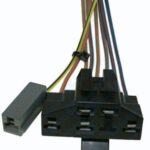Maintaining your 2013 Chrysler’s brake system is crucial for safety and performance. Sometimes, after performing brake work such as bleeding the brakes or replacing components, you might encounter issues with the Anti-lock Braking System (ABS) that require a reset. This is where understanding the process of using a specific scan tool to reset the ABS on your 2013 Chrysler becomes essential. Let’s delve into the details of proper brake bleeding and when and why a scan tool-based ABS reset might be necessary for your vehicle.
When working on your brake system, particularly if you suspect air has entered the lines, bleeding the brakes is a necessary procedure. Air in the brake lines can lead to a spongy brake pedal and reduced braking efficiency. As a starting point, it’s important to prevent air from entering the system in the first place. If you’ve had to disconnect brake lines, for instance when replacing a master cylinder, there are steps you can take to minimize fluid loss and air intake.
One helpful tip is to slightly depress the brake pedal and hold it in that position when disconnecting brake lines. This can be achieved by wedging a stick or a piece of PVC pipe between the seat base and the brake pedal. Depressing the pedal even about an inch can help to close off ports within the master cylinder, reducing fluid leakage. Additionally, using caps to seal the ends of disconnected brake lines is a good practice to further prevent fluid loss and contamination.
Once you are ready to bleed the brakes, there are several methods you can employ. A common approach is the gravity bleed method. For this, you attach a hose to the bleeder valve at the brake caliper, submerge the other end of the hose in a container partially filled with brake fluid, and then loosen the bleeder valve. You then simply wait for gravity to do its work, allowing old fluid and air to drain out. However, gravity bleeding can be slow, sometimes taking up to 30 minutes per wheel to see a consistent flow of new fluid. Always start bleeding from the wheel furthest away from the master cylinder and work your way closer.
Another method, often faster, is the pump and hold method, which typically requires a helper. One person pumps the brake pedal several times and holds it down, while the other person opens and closes the bleeder valve. This process is repeated until clear, bubble-free fluid emerges.
For a more efficient and less messy brake bleeding process, a pressure bleeder like a Motive pressure bleeder can be invaluable. These systems pressurize the brake fluid reservoir, allowing you to bleed the brakes at each wheel by simply opening the bleeder valve. When using a pressure bleeder, it’s essential to follow the instructions carefully to avoid creating a mess or damaging your brake system.
Here are some key steps when using a pressure bleeder:
- Begin by filling the brake fluid reservoir about halfway.
- For a complete brake bleed, it’s wise to have at least two large bottles of brake fluid on hand. Fill the pressure bleeder tank to the specified level with fresh fluid.
- Pressurize the system to around 15psi. Monitor the pressure gauge to ensure it holds steady and check the reservoir for any fluid level increase, which could indicate a cap seal issue. Crucially, never open the reservoir cap while the system is pressurized.
- Open each bleeder valve in turn, starting with the wheel furthest from the master cylinder, and observe the fluid flow until you see clean, new fluid without air bubbles.
- When finished or when refilling the bleeder tank, always relieve the pressure at the bleeder tank itself, not at the reservoir. Loosen the tank cap slowly to release pressure safely.
Now, coming back to the “2013 Chrysler Specific Scan Tool Reset Abs” keyword, in modern vehicles like your 2013 Chrysler, the ABS is an integral part of the braking system. Sometimes, even after successfully bleeding the brakes, you might find the ABS warning light remains illuminated on your dashboard. This can occur due to various reasons, including air being trapped in the ABS module itself, or if you have replaced an ABS component. In such cases, simply bleeding the brakes in the traditional way might not be sufficient to resolve the ABS issue.
This is where a 2013 Chrysler specific scan tool becomes necessary. These scan tools are designed to communicate with your vehicle’s computer systems, including the ABS module. They can perform several functions related to the ABS, such as:
- Reading ABS fault codes: Identifying the specific issue within the ABS system.
- Activating the ABS pump and solenoids: This can help to purge air trapped within the ABS module during the bleeding process, which standard bleeding methods might miss.
- Performing ABS reset or initialization procedures: After repairs or bleeding, the scan tool can be used to reset the ABS module, clearing fault codes and turning off the warning light.
Therefore, while understanding brake bleeding techniques is fundamental, for a 2013 Chrysler, especially when dealing with ABS related issues or after component replacement, having access to a specific scan tool capable of ABS reset functions can be invaluable. It ensures that your entire brake system, including the ABS, is functioning correctly and safely, providing you with peace of mind on the road. Using the correct scan tool and procedures will help you effectively maintain and troubleshoot your 2013 Chrysler’s ABS, ensuring optimal braking performance and safety.

